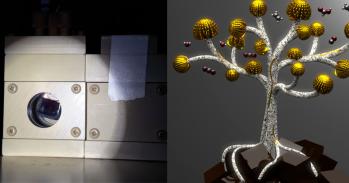
Scientists explore huge volume of molten rock now frozen into the crust under the ocean’s floor.
Scientists explore huge volume of molten rock now frozen into the crust under the ocean’s floor.
At the time of the break-up of the North Atlantic 55 million years ago there was a very sudden increase in global temperatures: in fact the earth has never been as hot since then, although the global warming that humans are now causing is likely to take the earth back to the same high temperatures as existed for a short period then.
Professor Robert White
For the first time scientists have mapped the layers of once molten rock that lie beneath the edges of the Atlantic Ocean and measure over eight miles thick in some locations.
The research, reported in this week's edition of Nature, gives us a better understanding of what may have happened during the break up of continents to form new mid-ocean ridges. The same volcanic activity in the North Atlantic may also have caused the subsequent release of massive volumes of greenhouse gases which led to a spike in global temperatures 55 million years ago.
The scientists, led by Professor Robert White, FRS at the University of Cambridge, also developed a new method of seeing through the thick lava flows beneath the seafloor to the sediments and structures beneath. The technique is now being employed to further oil exploration of the area which was previously restricted by the inability to image through the lava flows.
When a continent breaks apart, as Greenland and Northwest Europe did 55 million years ago, it is sometimes accompanied by a massive outburst of volcanic activity due to a 'hot spot' in the mantle that lies beneath the 55 mile thick outer skin of the earth. When the North Atlantic broke open, it produced 1-2 million cubic miles (5-10 million cubic kilometres) of molten rock which extended across 300,000 square miles (one million square kilometres). Most of the volcanic rock is now underwater and buried by more recent sediments. However the edge of this huge volcanic region is visible on land in a few places including the Giant's Causeway in Northern Ireland.
For the first time scientists mapped the huge quantities of molten rock in the North Atlantic. The rock had been injected into the crust of the earth at a depth of 5-10 miles (10-20 kilometres) beneath the surface along the line of the continental breakup 55 million years ago. Using seismic methods, they were able to map the layers of lava flows both near the surface and deep into the earth.
There is a considerable controversy at present as to whether the large scale volcanism was caused by abnormally hot mantle deep in the earth (a 'hot spot') or whether it was caused by some other means, such as a compositional change in the mantle that mean it could more easily be melted. The researchers demonstrate in this paper that the volcanic activity requires a temperature anomaly, supporting the 'hot spot' model.
Additionally, the scientists hope that a better understanding of what happened 55 million years ago will also provide insight into the changes that occur to the atmosphere and biosphere during volcanic activity.
Professor White said: "At the time of the break-up of the North Atlantic 55 million years ago there was a very sudden increase in global temperatures: in fact the earth has never been as hot since then, although the global warming that humans are now causing is likely to take the earth back to the same high temperatures as existed for a short period then.
"The increases in global temperatures are thought to have been caused by a massive release of methane from under the seabed - methane is almost 25 times worse than carbon dioxide as a greenhouse gas. A better understanding of volcanism and the underlying hot spot will help us understand how such activity might have triggered the methane release and subsequent global warming."
The researchers' findings also have implications for oil exploration in the region. Large volumes of oil have already been discovered (and are being extracted) in the sediments under the seabed between the Shetland Islands and the Faroe Islands. If these same sediments extend westward towards the Faroe Islands, as geological models suggest they do, there may be a lot more oil to be found.
However, because the sediments had thick layers of lava flows (molten rock) poured over them at the time the north Atlantic broke open, conventional exploration techniques have not been able to see through the lavas because they reflect the seismic energy. The scientists succeeded in developing a method of seeing through these thick lava flows to the sediments and structures that lie beneath them.
This work is licensed under a Creative Commons Licence. If you use this content on your site please link back to this page.





